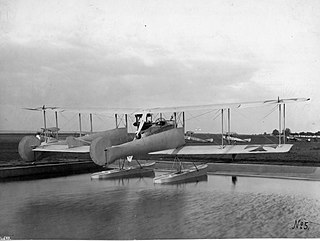
Between 1911 and 1914, the Royal Aircraft Factory used the F.E.2 designation for three quite different aircraft that shared only a common "Farman" pusher biplane layout.

The Vickers F.B.5 was a British two-seat pusher military biplane of the First World War. Armed with a single .303 in (7.7 mm) Lewis gun operated by the observer in the front of the nacelle, it was the first aircraft purpose-built for air-to-air combat to see service, making it the world's first operational fighter aircraft.

The Vultee XP-68 Tornado was a proposed American high-altitude interceptor aircraft. It was based on the experimental XP-54 Swoose Goose and powered by the Wright R-2160 Tornado 42-cylinder radial engine driving a set of contra-rotating propellers in a twin-boom pusher configuration. When the engine was cancelled on 22 November 1941, the XP-68 was also cancelled.

The AGO C.II was a German reconnaissance biplane of World War I. It was essentially a slightly redesigned version of the manufacturer's C.I design with a more powerful engine and 3-bay wings.

The AGO C.IV was a First World War German biplane reconnaissance aircraft.

The Airco DH.1 was an early military biplane of typical "Farman" pattern flown by Britain's Royal Flying Corps during World War I. By the time the powerplant for which it was designed was sufficiently plentiful it was obsolete as an operational aircraft, and apart from a few examples sent to the Middle East it served as a trainer and Home Defence fighter.

The Maurice Farman MF.11 Shorthorn is a French aircraft developed before World War I by the Farman Aviation Works. It was used as a reconnaissance and light bomber during the early part of World War I, later being relegated to training duties.

The Royal Aircraft Factory F.E.8 was a British single-seat fighter of the First World War designed at the Royal Aircraft Factory. It could not escape the drag penalty imposed by its tail structure and was no match for the Albatros fighters of late 1916.

The Friedrichshafen G.I was a prototype heavy bomber aircraft that was built in Germany by Flugzeugbau Friedrichshafen in 1915. It was Karl Gehlen's first design for the company, and although it was not produced in quantity, it provided the foundation for the later, highly successful bombers culminating in the G.III.

The Royal Aircraft Factory B.E.9 was a British experimental reconnaissance aircraft of World War I.
The Friedrichshafen FF.34 was a German biplane floatplane of the 1910s produced by Flugzeugbau Friedrichshafen.

The Gotha WD.3 was a pusher reconnaissance floatplane built in prototype form in Germany in 1915.

The Lohner L was a reconnaissance flying boat produced in Austria-Hungary during World War I. It was a two-bay biplane of typical configuration for the flying boats of the day, with its pusher engine mounted on struts in the interplane gap. The pilot and observer sat side by side in an open cockpit, and both the upper and lower sets of wings featured sweepback.

The Vickers F.B.12 was a biplane pusher fighter aircraft developed during World War I by Vickers Limited. The failure of the engine for which it was designed, and the obsolescence of the pusher configuration, resulted in its remaining an experimental type only.

The Albatros C.II was a 1910s German military pusher reconnaissance biplane designed and built by Albatros Flugzeugwerke. Only one aircraft was built and the type did not enter production.

The Vickers F.B.25 was a British two-seat night fighter prototype of World War I designed to attack enemy airships. Completed in 1917, it failed in its official flight tests that year and no order for production resulted.

The Otto C.I, also known as the Otto KD.15, was a German two-seat biplane reconnaissance and bomber aircraft of the First World War designed and produced by Otto Flugmaschinenfabrik. The C.I was a rare example of an aircraft flown by the Central Powers which had a pusher configuration.

The Siemens-Schuckert L.I was a large, three-engined biplane bomber aircraft, built in Germany towards the end of World War I. It was a twin boom design, strongly influenced by the successful Caproni Ca.3. Three were built but not used operationally.
The Germania C.I was a two-seat general-purpose biplane built by Germania Flugzeugwerke during World War I.

The Lohner M was a reconnaissance flying boat produced in small numbers in Austria-Hungary during World War I. It was a two-bay biplane of typical configuration for the flying boats of the day, with its pusher engine mounted on struts in the interplane gap. The pilot and observer sat side by side in an open cockpit, and both the upper and lower sets of wings featured sweepback.



















